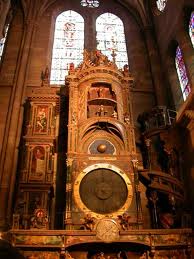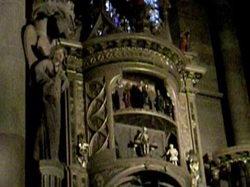8th Grade Webpage
Astronomical Clock

Strasbourg's astronomical clock is probably its best known and most unique feature. The present-day clock is one of the largest in Europe, but it took several attempts for the clock to succeed. The first version was built in 1352, but it only lasted 150 years before falling apart. In 1547, the idea to repair it was expressed, but religious complications postponed this for a little over thirty years. It wasn't until the nineteenth century that any lasting work was done.
The finished clock has four main levels. Though it does provide information, most people visit it to see the miniature performances http://www.pianola.org/history that occur at regular intervals throughout the day. Small figures
/history_mechanical.cfm move around to show the four ages of man; tiny cherubs bang on drums; a large hourglass turns over. The primary "show" occurs when a cock crows and the Apostles walk around Jesus at 12:30.
The clock showed some surprisingly advanced technology for such an early age, despite the fact that it only lasted 150 years. By the time it was renovated, technology had advanced considerably, although the workmanship was still considered stunning. The architects jealously guarded their secrets. In fact, the man who designed the clock was supposedly blinded so that he would not be able to repeat the remarkable feat.
http://wn.com/strasbourg_cathedral

